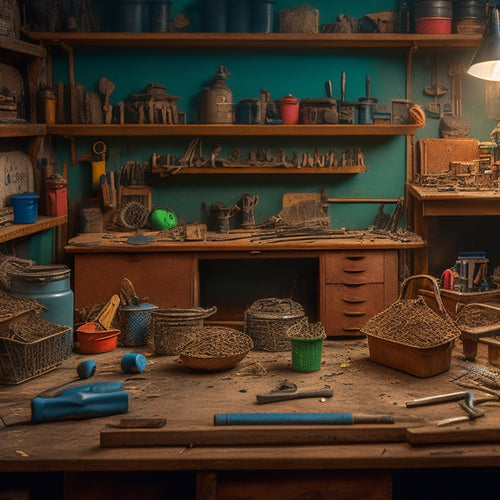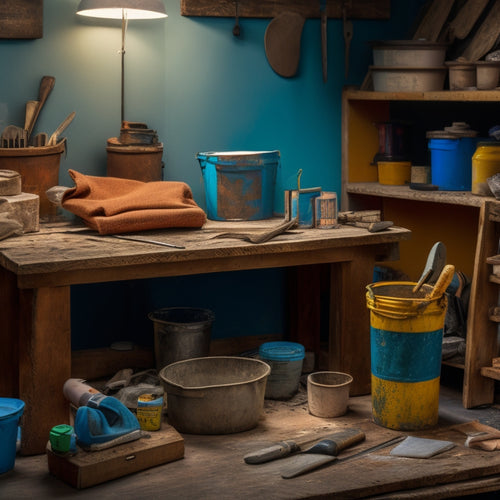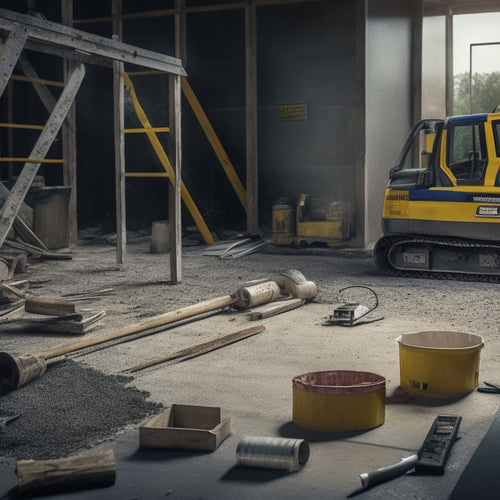
7 Tool Mistakes to Avoid in Interior Renovation
Share
When tackling an interior renovation, you'll want to avoid common tool mistakes that can lead to uneven finishes, wasted time, and costly setbacks. Choosing the wrong trowel size or edger type can result in poor application and uneven edges. Failing to prioritize safety gear and neglecting tool maintenance can compromise your finish quality and even put you at risk. Additionally, misusing power trowel extensions, skipping essential accessories, and inadequate mixer capacity planning can further derail your project. To guarantee a successful renovation, pay attention to these critical tool considerations - and discover the expert tips and tricks that will take your project to the next level.
Key Takeaways
• Choose the right trowel size for the job to ensure even coverage and avoid wasting material.
• Select the correct edger type and blade material for the specific task to achieve a quality finish.
• Maintain tools properly through regular sharpening, cleaning, and storage to extend their lifespan and ensure optimal performance.
• Wear essential safety gear, including hard hats, safety glasses, and dust masks, to prevent injuries and project delays.
• Plan mixer capacity according to the project's material coverage rate and area size to avoid messy outcomes and delays.
Choosing the Wrong Trowel Size
When applying adhesive or filler, you're likely to struggle with uneven coverage and wasted material if you're holding a trowel that's either too big or too small for the job. A trowel that's too large will leave thick, gloopy streaks, while one that's too small will require multiple applications, increasing the risk of unevenness.
To avoid this, select a trowel that matches the size of the area you're working on. For large surfaces, opt for a trowel with a long, flexible blade made of high-quality trowel material, such as stainless steel or fiberglass. This will allow for smooth, even application and minimize waste.
When it comes to trowel technique, hold the trowel at a 45-degree angle and apply gentle, consistent pressure. This will guarantee a uniform layer of adhesive or filler, reducing the risk of air pockets and bubbles.
Incorrect Edger Selection
You're likely to end up with uneven edges, wasted time, and a subpar finish if you don't select the right edger for your interior renovation project.
With so many edger types available, it's essential to understand the differences to make an informed decision. For instance, a rotary edger is ideal for curved cuts and intricate designs, while a straight edger is better suited for linear cuts and large surfaces.
When choosing an edger, consider the blade material as well. Carbide-tipped blades are durable and resistant to wear, making them perfect for heavy-duty projects. Diamond-coated blades, on the other hand, are designed for precision cuts and are ideal for working with tile, stone, or concrete.
Selecting the wrong edger can lead to uneven cuts, wasted materials, and a compromised finish. Take the time to research and understand the edger types and blade materials that best suit your project's specific needs.
Overlooking Safety Gear Essential
Frequently, renovators overlook the importance of safety gear, which can lead to avoidable injuries and accidents that derail the entire project.
As you initiate your interior renovation, remember that safety gear essentials aren't optional – they're a must-have. You'll need personal protective equipment (PPE) like hard hats, safety glasses, earplugs, and dust masks to safeguard yourself against falling objects, debris, and hazardous materials. Don't assume that a small renovation project doesn't require safety gear; even minor tasks can pose risks.
When selecting safety gear, verify it fits comfortably and is in good condition. Check the expiration dates of your equipment and replace them as needed. It's also important to follow the manufacturer's instructions for proper use and maintenance.
Inadequate Mixer Capacity Planning
Mixing the wrong materials or excessive quantities can lead to a messy catastrophe, causing project delays and wasted resources if you fail to plan for adequate mixer capacity.
You must consider the type of mixer you'll need for the job, as different mixer types are designed for specific tasks. For instance, a concrete mixer is ideal for large-scale projects, while a mortar mixer is better suited for smaller, more precise applications.
Before you start mixing, calculate the capacity required for your project. Measure the area to be covered, and factor in the material's coverage rate. This will help you determine the correct mixer size and avoid over- or under-mixing.
Don't forget to account for any obstacles or corners that may affect material distribution. Capacity calculations are critical to guarantee you have the right equipment for the job.
Misusing Power Trowel Extensions
When you're working with power trowel extensions, it's easy to get caught up in the task at hand and neglect the finer details.
But neglecting these details can lead to subpar results and even safety hazards.
Take a step back and assess your approach - are you holding the handle at the ideal angle, or is it causing you to lose control?
Incorrect Handle Angles
You're likely to sacrifice control and precision if you hold your power trowel extension at an angle that's too shallow or too steep, causing uneven material distribution and a rough finish. This mistake can lead to rework, wasted materials, and even injuries.
To avoid this, pay attention to your handle position. Hold the extension at a comfortable, ergonomic angle that allows you to maintain control and apply even pressure. A good rule of thumb is to keep the handle between 10-20 degrees from the surface you're working on. This will help you achieve a smooth, even finish and reduce fatigue.
When choosing a power trowel extension, look for one with an ergonomic design that fits comfortably in your hand. Consider the weight, balance, and grip of the handle, as well as the angle of the extension.
A well-designed tool will help you maintain a safe and comfortable working position, reducing the risk of strain and injury. By paying attention to your handle angle and choosing the right tool, you can achieve professional-looking results while keeping yourself safe on the job.
Insufficient Extension Length
As you focus on maintaining the ideal handle angle, it's equally important to confirm your power trowel extension is long enough to reach the surface without straining or overreaching, which can lead to uneven coverage and fatigue.
Insufficient extension length can force you to stretch or lean, compromising your balance and increasing the risk of accidents. Imagine working on a ladder, and your power trowel extension falls short, causing you to overstretch and lose your footing. This is a recipe for disaster.
Verify your extension cord is long enough to allow you to work comfortably without straining. Check the cord's length and consider the distance between the power source and the work surface.
It's also vital to maintain ladder stability by always placing it on a level, firm surface and confirming all four legs are sturdy. When using a ladder, never lean over the side or overreach, as this can cause the ladder to tip or slip.
Overreaching With Extensions
Misusing power trowel extensions by overreaching can lead to a loss of control, causing uneven coverage, and putting you at risk of accidents, fatigue, and even injury. When you overreach, you're compromising your stance, balance, and grip on the tool, making it difficult to maintain a steady hand. This can result in unevenly applied materials, waste, and rework.
To avoid overreaching, make certain you're using an extension that's compatible with your power trowel. Check the manufacturer's recommendations for extension compatibility to guarantee a secure fit. Also, consider the extension's stability; a sturdy extension will provide better support and balance, reducing the likelihood of accidents.
Additionally, assess the area you're working on and plan your approach accordingly. Break down large areas into smaller sections, and use your extension to reach those hard-to-access spots. By doing so, you'll maintain better control over your tool, reduce fatigue, and minimize the risk of injury.
Neglecting Finishing Tool Maintenance
As you prep for your interior renovation project, you're probably focused on the big picture - envisioning the perfect color scheme, selecting the ideal flooring, and planning the layout.
However, it's the small details that can make or break your project. Neglecting finishing tool maintenance is a common mistake that can lead to costly setbacks.
Tool Wear and Tear
Neglecting regular sharpening and cleaning of your finishing tools can lead to dull, rusty, and worn-out blades, pads, and bits, compromising the quality of your interior renovation project. You might think it's no big deal, but worn-out tools can cause uneven finishes, scratches, and even accidents.
To guarantee tool longevity, make it a habit to inspect your tools regularly for signs of wear and tear. Check for rust, dullness, or damage on blades and bits, and clean or replace them as needed.
Proper maintenance tips include storing tools in a dry, clean environment, away from direct sunlight. For tools with moving parts, apply lubricants to prevent corrosion. Regularly sharpening your blades and bits will also help maintain their effectiveness.
Regular Cleaning Schedules
By establishing a regular cleaning schedule, you can prevent the buildup of debris, dust, and residue that can compromise the performance and longevity of your finishing tools. A consistent cleaning frequency helps maintain the precision and accuracy of your tools, ensuring they continue to deliver high-quality results. Neglecting this vital step can lead to tool failure, damage to materials, and even safety hazards.
To create an effective cleaning schedule, start by identifying the tools that require regular maintenance. Develop a maintenance checklist that outlines the specific tasks and frequency for each tool. For instance, you may need to clean your sanders daily, while your paintbrushes may only require weekly attention.
Be sure to include tasks such as dusting, lubricating, and replacing worn parts. By following your schedule and checklist, you'll be able to detect potential issues early on, preventing costly repairs and downtime.
Skipping Essential Tool Accessories
When tackling an interior renovation project, you'll likely reach for your trusty power drill, circular saw, or impact driver, but often overlook the essential accessories that can make or break the efficiency and quality of your work.
Skipping these accessories can lead to subpar results, wasted time, and even safety hazards.
To avoid this pitfall, prioritize tool storage and accessory organization. Designate a specific area for your tools and accessories, ensuring they're easily accessible and well-maintained.
Invest in a tool chest or cabinet with dividers and compartments to keep everything organized. This will prevent misplaced or lost accessories, reducing downtime and frustration.
Additionally, a well-organized workspace reduces the risk of tripping hazards and accidents. Take the time to inventory your accessories, and make sure you have the necessary bits, blades, and attachments for each tool.
Frequently Asked Questions
Can I Use a Drill as a Makeshift Mixer in a Pinch?
When you're in a bind, you might think using a drill as a makeshift mixer is a good idea, but don't do it!
Drills are designed for specific tasks, and mixing isn't one of them. You risk damaging the drill or injuring yourself.
Instead, invest in a dedicated mixer or learn various mixing techniques, like folding or whisking, to get the job done safely and effectively.
Are All Safety Goggles Created Equal for Renovation Work?
As you step into the renovation zone, your eyes are the windows to your world, and safety goggles are the curtains that shield them.
But don't assume all goggles are created equal. You need to scrutinize the goggle protection standards, ensuring they meet ANSI Z87.1 standards.
Additionally, consider lens tint options - anti-fog, scratch-resistant, or tints for specific tasks.
Don't compromise on your vision; choose goggles that provide high-quality protection and ideal visibility for a safe and successful renovation project.
What's the Ideal Temperature for Working With Epoxy-Based Materials?
When you're working with epoxy-based materials, you'll want to verify the ideal temperature for maximum epoxy curing.
You'll find the sweet spot between 70°F to 80°F (21°C to 27°C), as this temperature range allows for a smooth, bubble-free finish.
Make certain to maintain a consistent temperature, as fluctuations can affect the curing process.
Can I Use a Power Trowel on Newly Poured Concrete Floors?
When working on newly poured concrete floors, you'll want to exercise caution with power trowel techniques.
Avoid using a power trowel too soon, as it can disrupt the concrete's setting process. Instead, wait until the floor has reached the 'floated' stage, where it's still pourable but holds its shape.
Then, use gentle, sweeping motions to finish the surface, following essential concrete finishing tips to achieve a smooth, even finish.
How Often Should I Sharpen My Finishing Trowel for Optimal Results?
As you wield your trusted finishing trowel, imagine a razor-sharp blade slicing through butter, leaving a trail of smooth, velvety perfection.
To maintain this level of mastery, you should sharpen your trowel every 1-2 hours, or when you notice a decline in finishing techniques. Regular trowel maintenance is key to achieving flawless results.
A dull trowel can lead to uneven finishes, wasted time, and even safety hazards. Stay sharp, stay safe, and your craftsmanship will shine like a polished gem.
Conclusion
You've made it through the renovation minefield! Now, go forth and conquer with the right tools.
Research suggests that up to 75% of DIYers regret not investing in quality tools from the start. Don't be one of them.
By avoiding these 7 tool mistakes, you'll save time, money, and your sanity.
Remember, the right tools are an investment in your project's success – and your own peace of mind.
Related Posts
-

Why Tool Exchange Matters in Home Renovation
You rely on a well-maintained tool belt to complete home renovation projects efficiently, and having access to the ri...
-

DIY Plastering Supply Checklist for Home Renovation
To tackle a DIY plastering project for your home renovation, you'll need a solid checklist of supplies. Start with es...
-

Home Renovation Safety Checklist for Homeowners
As a homeowner initiating a renovation project, you know that safety should be your top priority. Start by establishi...


